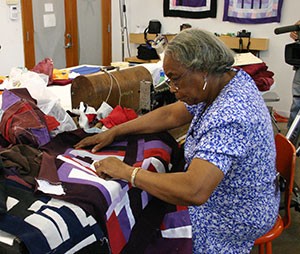Born 1935, Boykin (also “Gee’s Bend”), Alabama
During the Great Depression, photographs and stories depicting the exceptional poverty of the rural community known as Gee’s Bend, Alabama, drew national attention. As part of the New Deal, federal initiatives facilitated homeownership and produced the stability that underlay the unique persistence of the community’s quilting tradition. In 1940 Mary Lee Bendolph and her family moved into one of the “Roosevelt houses” built by the Resettlement Administration. She participated in events during the civil rights era, joining the march to Camden after Martin Luther King Jr. visited in 1965 and entreated residents to register to vote. She briefly worked for the Freedom Quilting Bee in 1968. In 1999 Bendolph’s story was at the center of a Pulitzer Prize–winning article on Gee’s Bend by J. R. Moehringer published in the Los Angeles Times. She stopped quilting around this time, only to resume following the success of the 2002 traveling exhibition The Quilts of Gee’s Bend.
Inspired by her experience of the exhibition, Bendolph began to conceive of her quilts primarily as aesthetic objects and subsequently experimented with printmaking. She continues to work primarily with salvaged pieces of work clothes and other remnants. This approach, originally borne of scarcity and utilitarian need, has become both an ethic and aesthetic: a way of metamorphosing the traces of hard labor and want into a manner of solace. But it is not just this history of wear and use that is incorporated into her textiles. Like many women of Gee’s Bend, Bendolph often finds inspiration in the built environment. Local vernacular structures, such as Roosevelt houses fitted with annexes and ad hoc repairs, are reflected in her architectonic constructions sewn in wool, denim, cotton, corduroy, and polyester.
The “housetop” pattern, also known as the popular “log cabin” design in white American quilting traditions, is among the most widely used in Gee’s Bend. Beginning with a central square, strips of fabric are pieced at right angles extending outward. As is clear in Blocks and Strips, the simplicity of this construction serves as the basis for seemingly infinite variety. Using asymmetry and color to break up the underlying pattern, Bendolph orchestrates a composition of energetic, rhythmic complexity, such as the bold red, black, and white design of Blocks, Strips, Strings, and Half Squares.
Jenevive Nykolak
Arnett, Paul, Joanne Cubbs, and Eugene W. Metcalf, eds. Gee’s Bend: The Architecture of the Quilt. Atlanta: Tinwood Books, 2006.
Beardsley, John, et al. Gee’s Bend: The Women and Their Quilts. Houston: Museum of Fine Arts, with Tinwood Books, Atlanta, 2002.
